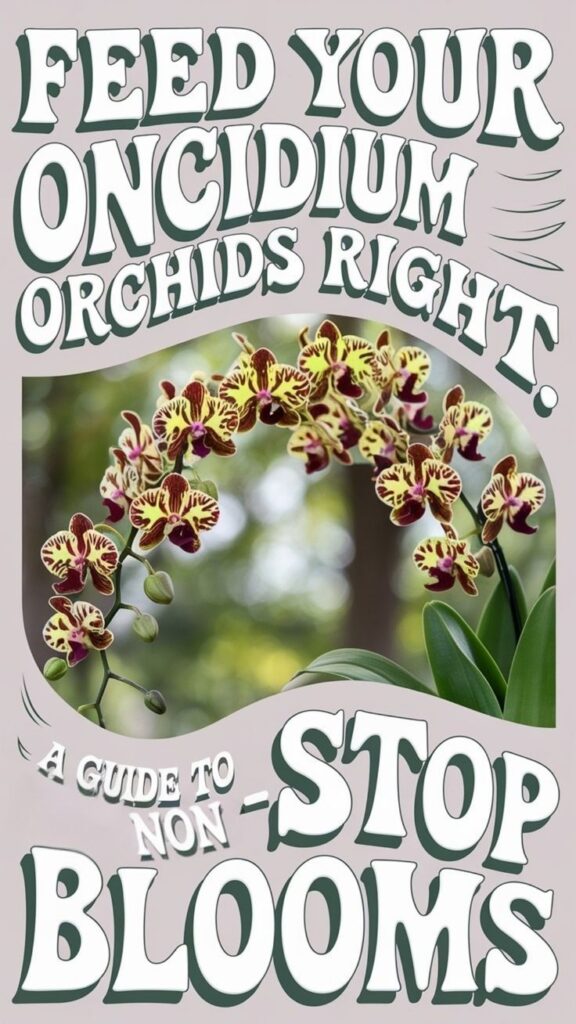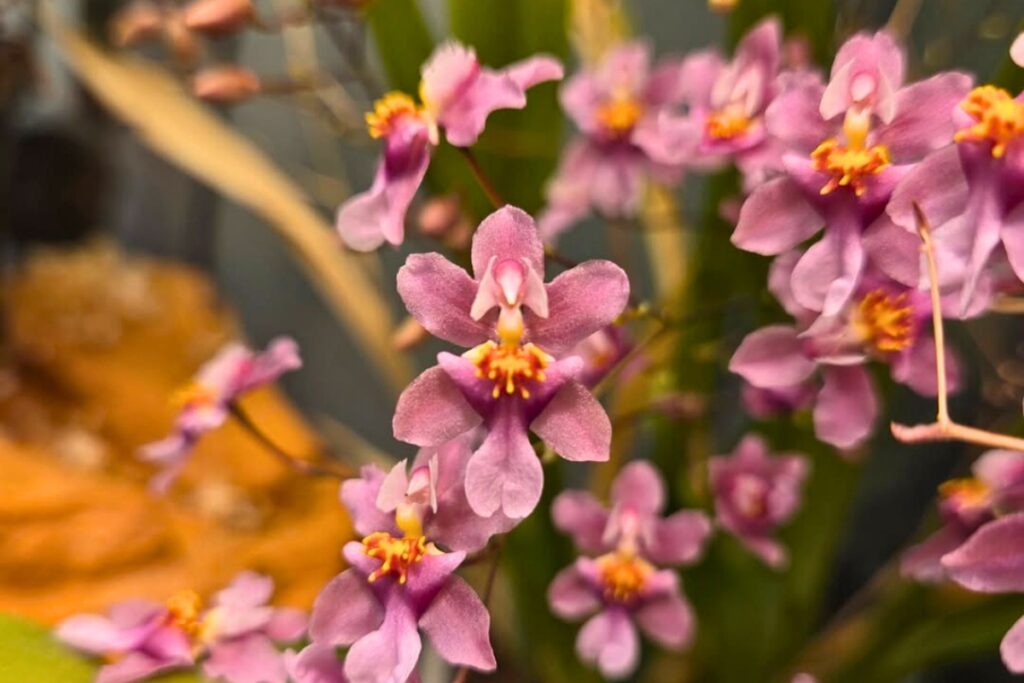While many orchid enthusiasts believe that fertilizing Oncidium orchids is simply a matter of following a fixed schedule, the truth is far more nuanced. You’ll need to contemplate your plant’s growth cycle, water quality, and environmental conditions to develop an effective feeding strategy. When you’ve mastered the art of fertilizing these stunning orchids, you’ll unleash their full blooming potential – but first, let’s clear up some common misconceptions about nutrient timing and concentration that might be holding your plants back.

Contents
Understanding Oncidium Orchid Nutrient Requirements
Oncidium orchids require a delicate balance of nutrients to thrive and produce their stunning sprays of flowers. You’ll need to provide nitrogen, phosphorus, and potassium in a 20-20-20 ratio during the growing season, switching to a 10-30-20 blend when flower spikes emerge.
These orchids are light feeders, so you’ll want to fertilize at quarter-strength every two weeks during active growth. During winter’s rest period, reduce feeding to once monthly. Your orchid will signal its needs through leaf color – bright green indicates sufficient nutrients, while yellowish leaves suggest it’s time for a feeding.

Best Fertilizer Types for Oncidium Orchids
When selecting fertilizers for these elegant bloomers, you’ll want to focus on water-soluble formulations specifically designed for orchids. Look for balanced NPK ratios like 20-20-20 or 30-10-10, which provide essential macronutrients for healthy growth.
During active growth periods, urea-free fertilizers work best since they’re gentler on Oncidium roots. You’ll find that balanced fertilizers with micronutrients, particularly calcium and magnesium, help prevent yellowing leaves and weak stems.
If you’re growing indoors, quarter-strength fertilizer applications every two weeks will suffice. For mounted or basket-grown Oncidiums, increase to half-strength weekly, as nutrients flush through more quickly in these setups.
Seasonal Fertilizing Schedule
Understanding how to adjust your fertilizing routine throughout the year will maximize your success with these orchids. During spring and summer’s active growth, feed your Oncidium every 2-3 weeks with a balanced 20-20-20 fertilizer at quarter strength.
As autumn approaches, reduce fertilizing to once monthly and switch to a high-phosphorus formula (10-30-20) to encourage blooming. You’ll want to cut back considerably during winter’s dormancy period, fertilizing only every 6-8 weeks.
Remember to skip fertilizing if your orchid’s potting medium is completely dry, and always water thoroughly before applying nutrients to prevent root damage.
Signs of Over and Under Fertilization
Your Oncidium orchid will tell you when it’s not getting enough nutrients through yellowing leaves, stunted growth, and weak flowering stems. When you’ve gone overboard with fertilizer, you’ll notice leaf tip burn, crusty white mineral deposits on the potting media, and roots that look brown and damaged. Learning to spot these warning signs early can help you adjust your fertilizing routine before serious damage occurs.
Nutrient Deficiency Warning Signs
How can you tell if your Oncidium orchid is struggling with nutrient issues? Watch for key warning signs in the leaves, as they’ll tell you what’s missing from your plant’s diet.
Yellow leaves with green veins typically indicate an iron deficiency, while overall pale foliage points to nitrogen problems. If you’re seeing purple-tinged leaves, your orchid’s likely running low on phosphorus. Dark green leaves with stunted growth suggest a lack of calcium.
The leaf tips might turn brown and die back when there’s not enough potassium. You’ll also notice slower growth, smaller flowers, and weak stems if your orchid isn’t getting proper nutrition.
Too Much Fertilizer Damage
While nutrient deficiencies can harm your Oncidium orchid, excessive fertilizer often causes even more severe damage. You’ll notice the first signs when leaf tips turn brown and become crispy, followed by yellowing edges that spread inward.
Root damage is another clear indicator – they’ll appear dark brown or black, feel mushy, and may start rotting. If you spot white crystal deposits on the potting mix, that’s salt buildup from over-fertilization.
To save an over-fertilized orchid, immediately flush the growing medium with clean water for 5 minutes. Don’t fertilize for at least two months, and when you restart, use only half-strength solutions.
Water Quality and Fertilizer Application Methods
For successful fertilization of Oncidium orchids, using the right water quality and application methods makes all the difference. You’ll want to start with room-temperature water that’s low in dissolved solids, ideally under 200 ppm. If you’re using tap water, let it sit for 24 hours to dissipate chlorine.
Apply your fertilizer solution by thoroughly drenching the potting medium until it runs through the drainage holes. Don’t forget to target the roots, not the leaves or pseudobulbs. For best results, fertilize in the morning and alternate between clear water and fertilizer solution every other watering.
Adjusting Fertilizer Ratios During Growth Cycles
Just as your Oncidium orchid’s needs change throughout its growth cycle, you’ll need to adjust your fertilizer ratios accordingly. During active growth, use a balanced 20-20-20 fertilizer every two weeks to support leaf and pseudobulb development.
When you notice flower spikes emerging, switch to a high-phosphorus formula (10-30-20) to encourage blooming. Apply this every 10-14 days until the flowers open fully.
After blooming, reduce fertilizing to once monthly with a lower-nitrogen blend (10-10-30). During winter dormancy, cut back to quarterly feedings at half strength, which will help maintain root health without promoting unwanted vegetative growth.
